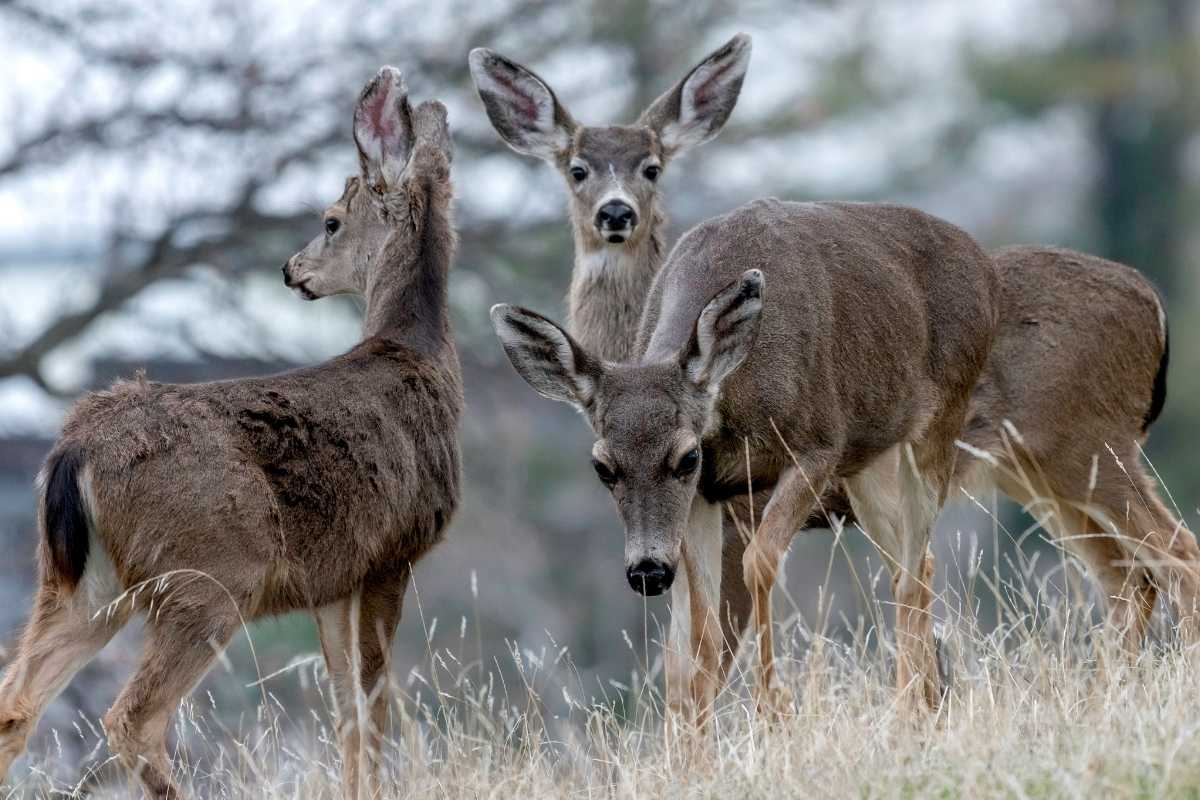When a deer gently taps the earth, it’s not practicing its dance moves—communicating with its kin. As you watch this graceful creature, you might wonder why it pounds the ground with such intention.
It’s a warning, a signal to other deer that something isn’t quite right.
You see, deer are equipped with a natural alert system, and that stomp you’ve observed is their version of a red flag.
It tells their herd that potential danger is nearby, and it tells you that you’ve been spotted.
As you explore the reasons behind this behavior, you’ll learn how deer use their hooves to speak to each other and the world around them, ensuring their survival.
You’re not just witnessing a random act; you’re getting a glimpse into the complexities of deer communication.
Contents (Jump to Topic)
ToggleDeer Communication Basics
You’ll find that they employ various communication methods alongside hoof stamping within the intricate world of deer behavior.
Their non-verbal communication includes body language, such as ear movements and tail flicks, which convey vital information within the herd.
Additionally, deer sounds play a significant role; from soft grunts to loud snorts, each vocalization serves a specific purpose: signal alarm or maintain social bonds.
These auditory cues, coupled with the strategic placement of interdigital scents through hoof stamping, create a complex communication network that’s critical for their survival.
This multifaceted system is a testament to the deer’s adaptability and social intelligence.
Alerting to Potential Danger
When you’re near a deer, and it starts to stomp its feet, it’s signaling the presence of potential danger to its herd.
This behavior is a critical warning sign, honed by evolution to ensure their survival.
An alert deer uses the sound and scent released during stomping to communicate with its herd.
The repeated stamping sends vibrations through the ground and disperses interdigital scents, which other deer can sense. This alerts them even if they can’t see the source of the threat.
The action serves a dual purpose: it warns the herd and indicates to potential predators that they’ve been detected.
Differences in Gender Behavior
You mightn’t realize it, but both male and female deer exhibit foot-stomping behavior, though the reasons behind their actions can vary.
Female deer stomp their feet to alert others to potential threats and lay down the scent, particularly when a doe with fawns feels heightened concern for their safety.
They’re more vigilant, and their stomping serves a dual purpose of communication and protection.
On the other hand, bucks often use foot-stomping as part of their assertive displays, especially during mating season, to establish dominance or deter competitors.
While both genders stomp to signal alertness, the underlying motivations are nuanced, reflecting their roles within deer society and differing priorities regarding reproduction and parental care.
Human Encounters and Responses
During encounters with deer, it’s crucial to interpret their stomping as a sign they’ve sensed your presence and may consider you a threat.
Deer stomping is an alert mechanism that can occur during human encounters, indicating that the deer is on high alert and assessing the level of danger you might pose.
Your response should be informed and cautious to avoid escalating the situation.
- Freeze: Minimize movement; sudden actions can startle deer further.
- Silence is Key: Avoid making noise that could be perceived as a threat.
- Observe: Watch for additional signals, like snorting or head bobbing, indicating how the deer assesses the threat level.
Associated Vocalizations
Deer often accompany their foot-stomping with distinctive snorts or blows, signaling heightened alertness to their herd and potential threats.
These vocalizations, specifically the deer snort, are more than just arbitrary noises; they’re strategic communications that convey urgency and caution.
When a deer snorts or blows, it’s not merely reacting in isolation. The sound acts as an acoustic beacon, alerting others to potential danger.
The deer snort isn’t a simple exhalation but a calculated part of the deer’s repertoire for survival, ensuring the herd’s safety through a combination of sound and scent markers left by the stomping.
Non-Verbal Signals
Here’s a closer look at deer body language:
- Tail Positioning: A raised tail can signal an alarm or visual cue to others that something is amiss.
- Ear Movements: Deer will rotate their ears to listen intently, indicating their focus and alertness to the surroundings.
- Posture: An attentive, rigid stance may denote caution and readiness to react to threats.
Understand that these aspects of body language are critical for silent communication among deer, ensuring they stay alert and informed of any dangers.
Understanding Deer Body Language
The intensity of a foot stomp is a nuanced aspect of deer body language that reveals their level of concern.
Lighter stamping may indicate curiosity or minor alarm, whereas vigorous stamping suggests an immediate threat.
This behavior isn’t just for show; it’s coupled with the release of interdigital scents, layering olfactory signals onto the visual warning.
Such communication among deer is vital for herd cohesion and predator evasion. Leonard Lee Rue III’s research emphasizes the sophistication of these interactions.
For hunters, recognizing these signs is critical; it can mean the difference between a successful hunt and an educational encounter with wildlife.
Observing Deer in the Wild
When observing wildlife, your patience and stillness are vital to witnessing deer’s subtle yet intricate behavior in their natural habitat.
- Intensity of Stamping: Light, cautious stamps may escalate to aggressive pounding as a deer becomes more alert.
- Interdigital Scent: Each stamp releases a scent, adding a layer of olfactory messaging to the visual display.
- Observer’s Conduct: Your reaction should be as unobtrusive as possible to avoid disrupting the deer’s natural behavior.
Before you go…
A stomp isn’t just a gesture—it’s a survival tool. Does signal alarm, conveying urgency across the herd with a hoof’s percussion.
Gender nuances influence their alerts, and your presence triggers a calculated response.
Their stomps, vocal cues, and subtle body language compose a complex dialogue.
Next time you’re in the forest, watch closely.
Sources:
https://www.mossyoak.com/our-obsession/blogs/deer/how-to-read-whitetail-body-language
https://worlddeer.org/why-do-deer-stomp/
https://www.deeranddeerhunting.com/content/blogs/dan-schmidt-deer-blog-whitetail-wisdom/deer-stomping-foot-what-does-it-mean







Conversation | 1 comment:
Awesome article.new basics but it was indepth an informative.